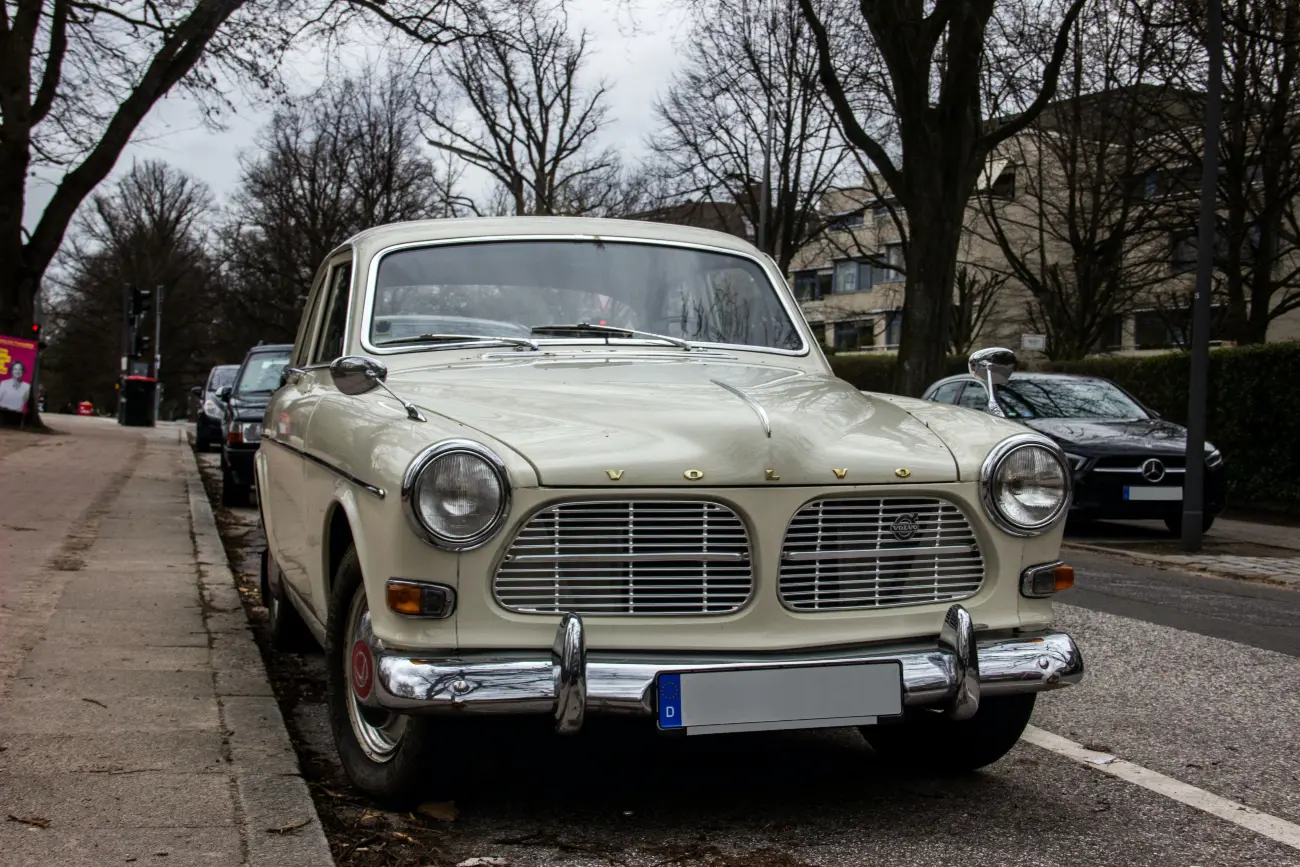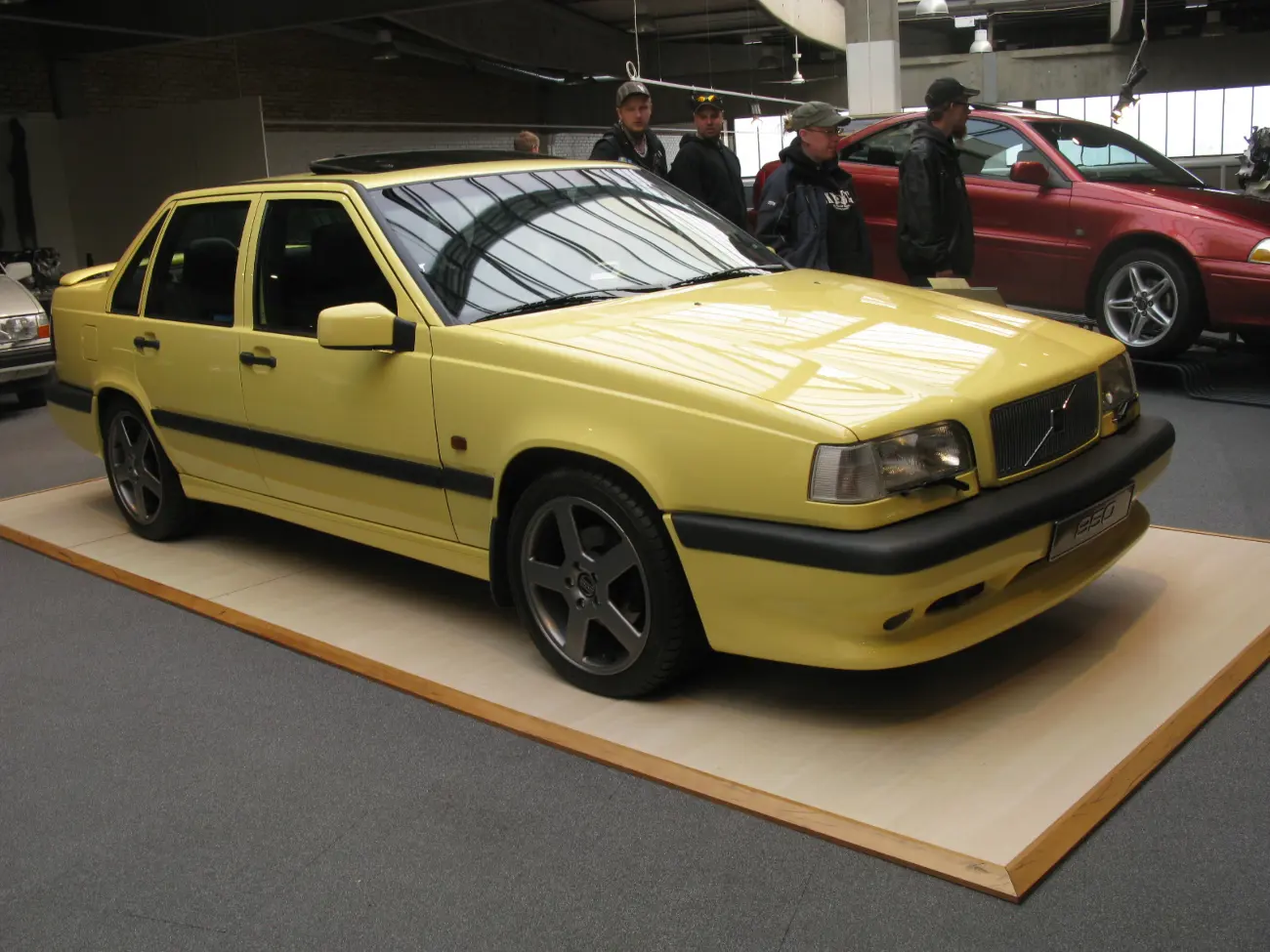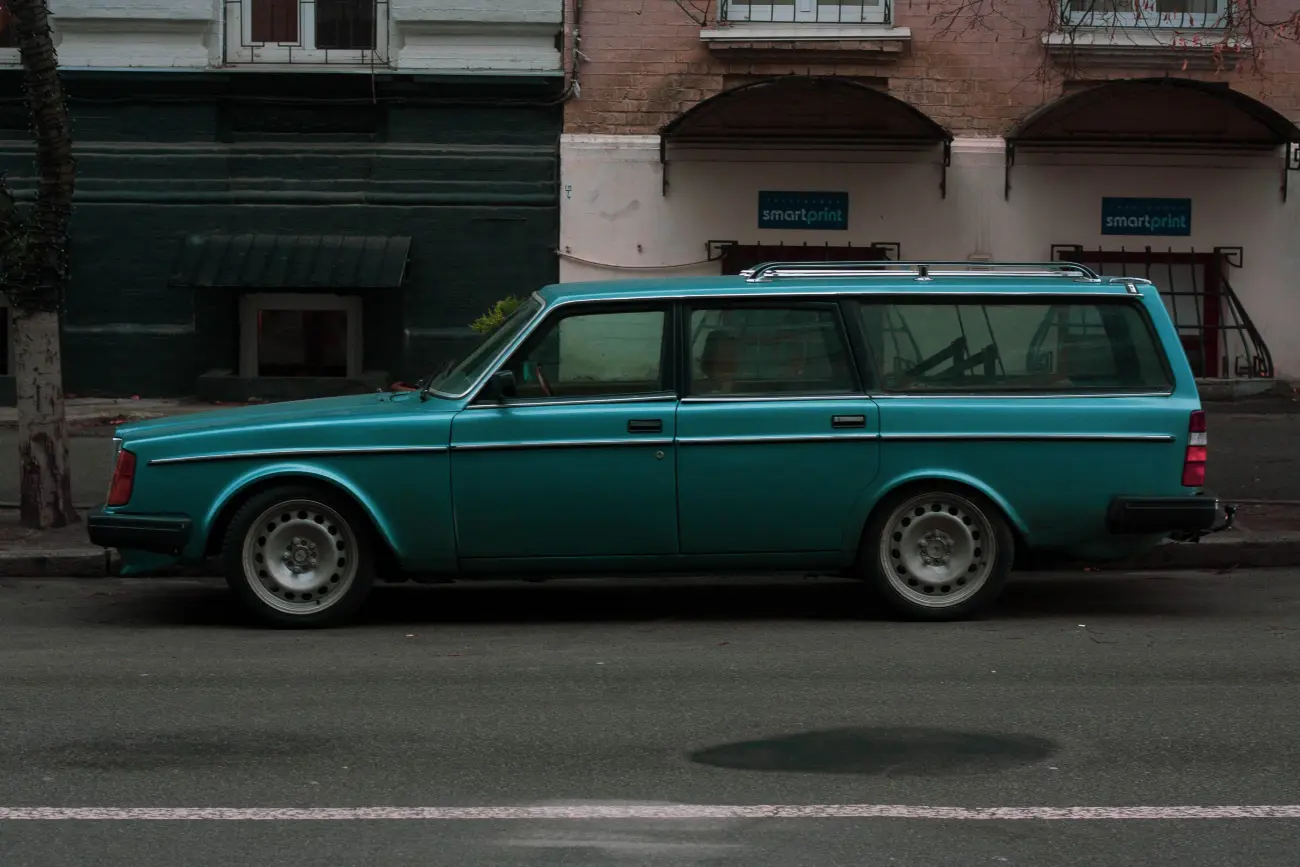Best classic Volvos
19 January 2022
You could definitely argue that Swedish car manufacturers Volvo have one of the best-defined brand images out there.
Think 'Volvo' and, as likely as not, something very particular comes to mind – a boxy, sturdy estate car, quite possibly from the 1980s. Perhaps not the sexiest thing ever built, but definitely with its own chunky, bulletproof charm. And, crucially, something that would make you – and your family – feel very safe to sit inside, whether you were on the school run or a camping trip to France.
Our favourite classic Volvos follow. If you’d like to add one of these super Swedish motors to your collection, call the specialists at Lancaster for a classic car insurance quote.

Volvo PV444 / PV544
Produced from 1947 to 1966, the PV444 saloon marked the moment when Volvo (who'd been building cars since 1927) first obtained their reputation for building safe, sturdy vehicles.
The PV444 had its origins back in the early years of World War II, when it became clear to the Swedish marque that fuel was likely to be at a premium for a good few years. Given this, a small car that could deliver decent fuel economy was likely to be a commercial success. A shortage of raw materials only underlined the case for downsizing.
Swedish buyers got their first look at a 444 in, well, '44. The car met with an immediately positive response – and a full order book. Due to the difficulties of getting factory facilities up and running, production of the PV444 didn’t begin until 1947.
The car quickly won itself a reputation for ruggedness and durability, as you'd want when navigating the post-war roads of Scandinavia. Swede Gunnar Andersson drove to victory at the 1958 European Rally Championship in a PV444. Later, the car's PV544 successor – driven by Joginder Singh, aka 'The Flying Sikh' – famously triumphed in Kenya's 1965 Safari Rally.
Volvo Amazon
The PV444 and PV5444 were loveable cars but looked, in truth, just a little behind the curve – even on their introduction. Their successor, the Amazon, was a more sleek and streamlined beast. Starting off a family tree that many future Volvos would imitate, the Amazon was available in two- and four-door saloon forms, plus – of course – a roomy estate. It also wrote a significant chapter in the history of automobile safety, becoming the first car to feature front seat belts as standard equipment (a feat it later embellished by becoming the first model to offer three-point seat belts).
Like the mythical female warriors from whom it borrowed its name, the Amazon was a striking-looking thing, with a strong profile, well-defined 'shoulders', and tailfins. It was built from phosphate-treated steel, improving paint adhesion, and also got an oil treatment to ward off rust. This accounts for the fact that Amazons were still seen in garages and out on the road for many years – even decades – after the car ceased production.
Volvo P1800
Ah, the P1800. Arguably the most sinuous, elegant car Volvo have ever built, this curvy '60s coupe won legions of fans including, famously, Roger Moore as Simon Templar in the iconic TV series The Saint. Incidentally, Moore was originally slated to drive a Jaguar Mk X, but waiting lists for that car were so long during the winter of 1961-62 that the Big Cat did not feel like donating one to a new TV series of (as yet) unknown quality.
The car was based on the mechanicals of the Amazon above: styling came from Swedish designer Pelle Petterson. The latter was employed at the time in the studio of Pietro Frua, himself well known for such curvy '50s/'60s beauties as the Maserati Mistral and AC 428 Spyder.
The P1800 even had some British DNA: for its first two years of production, the car was assembled by Jensen right here in the UK.
Volvo 1800ES
The Reliant Scimitar, the Lancia Beta HPE, the rare-as-hen's-teeth Jensen GT and Gilbern Invader: yes, the 1970s were a golden age for the shooting brake.
These graceful three-door small estates were basically extended versions of popular coupes of the day (such as the standard Beta, or the Jensen-Healey), endowed with a bit of extra boot space for a weekend away.
Volvo got in on the act in some style with the 1800ES, their shooting-brake reimagining of the elegant P1800. The latter, though revered, was starting to look a little old-school in the wedgy early 1970s: this mini-estate variant, with its frameless, all-glass tailgate, dragged the model right into the present.
Like the other shooting brakes above, the 1800ES could get you to that weekend away in double-quick time, managing a very respectable 120mph top speed.
Just over 8,000 ES models were made, making it a rare and highly prized classic today – although its legacy lived on in the all-glass tailgates of the later 480 and C30 coupes. Any models still in circulation will be lovingly maintained, and protected with some specialist classic car insurance.
Volvo 140 / 160 series
Introduced in 1966, the 140 series represented the moment when Volvo went all square-jawed and slab-sided, introducing the ruggedly handsome looks that would define the company for decades. Indeed, the last 240 series cars that slid off the production line in 1993 didn't look substantially different to their late '60s predecessors.
This was a shape that said 'safety' and 'reliability'. When it turned out, moreover, that the car did offer real prowess in those areas, it made the 140 and its 240 successor into huge sales successes – and familiar sights on roads across Europe for decades.
Buyers could choose between four cylinders (140) and the rarer six-cylinder cars (160). The last digit, meanwhile, denoted the number of doors – so a 142 was a two-door saloon, a 144 the four-door equivalent, and the 145 the five-door estate form. The latter sold in huge numbers here in the UK, binding together the words 'Volvo' and 'estate' for decades to come.
Volvo 240
If you grew up in the 1980s or 1990s, you almost definitely had a few rides in the back of a big, boxy Volvo 240 estate. It was the safe, sturdy family transport for years on end.
But how much did it actually move the game on from its 140-series predecessor? Well, the 240 cars got a host of new features including MacPherson strut suspension for better comfort. Safety came even more to the fore, with more impact-absorbing interiors, and bigger bumpers. Once again, your basic options were the 242 two-door and 244 four-door saloon, and the big seller, the 245 estate.
The car was built like a tank, and the boot would swallow large items of furniture, making the 245 a favourite of antiques dealers, among others. This generation of Volvos also proved nicely rust-resistant, so was still seen in good numbers well into the 2000s.
Now, they can be bought cheaply and may still give you tens of thousands of relatively stress-free miles. There will undoubtedly be some restoration and maintenance projects down the track, however, so we'd recommend some classic car cover.
Interesting variants included the 120mph 245 Turbo, an early example of our fascination with fast estates. These spin-offs culminated with the extraordinary, Bertone-styled 262C, an unwieldy but weirdly fascinating splicing of Volvo chunkiness and coupe svelteness, beloved by David Bowie among others.

Volvo 343
The short, stubby Volvo 343 was one of the biggest-selling cars throughout the 1980s here in Britain – and it has an interesting origin story. It had been developed by Dutch truck and car manufacturers DAF, who'd then been bought by Volvo in 1975.
Through the 1950s and 1960s, DAF's passenger car division had turned out a series of successful small compact cars. Now, it wanted to build a larger model, but needed a construction partner. In the late '60s, DAF approached Audi, BMW – and Volvo.
The latter weren't at first interested: later, convinced by DAF's access to Renault engines, they relented and a deal was done. What's more, producing the car in DAF's native Netherlands gave Volvo access to markets around the EEC that, with Sweden not yet a member, would otherwise have been closed to them.
Volvo purchased a one-third share in DAF in 1973, increasing to a three-quarters stake in 1975. So it was that a car that started life as the DAF P900 became the Volvo 340 series.
And yes, it was a popular car here in Britain. Was it the chunky looks we enjoyed? Volvo's now unparalleled reputation for safety? Or the fact that the 343 was one of the first cars to come with a catalytic converter, cleaning harmful gases before they left through the exhaust pipe?
Whatever the reason, Volvo's small family car was a regular in the UK's annual top 20 sales charts. The fact that they are robust and, mechanically, fairly simple (and easy to look after) won't have harmed their popularity, either. These days, the car's rear-wheel drive layout and relatively low running costs make it a good candidate as a fun, affordable project car.
Just make sure you have some classics insurance as you restore your 343 to its former glory.
Volvo 480
It's an interesting fact about the Volvo 480 that the car got one of its key features in readiness for an overseas market that, ultimately, it never conquered.
Yes, the 480 was aimed at American buyers, and got some chunky bumpers as a result, designed – as per US law – to withstand a 5mph shunt without any damage to the lights, safety equipment or engine. However, in the end the 480 never made it over the Atlantic.
No matter, as it became a popular small family car over here in Europe. Deservedly so, as it was a sleek-looking thing, with its cheese-wedge shape, pop-up headlights and Volvo badge placed discreetly under the front bumper.
It was also a genuine departure for Volvo: after decades of safe, earnest and foursquare saloons and estates, the low, lithe and graceful 480 bore faint echoes of the P1800 and, especially, its ES shooting brake variant, with which it also shared that frameless glass rear hatch.
The 480 was a groundbreaker in another way, too: it was Volvo's first front-wheel drive car. Given that generations of Volvos would employ the FWD format from here on, this was a significant innovation – and makes another compelling reason for putting the 480 onto our halo board of great Volvos.

Volvo 850
A few different Volvos had a go at replacing the iconic 240 series. Though very decent cars, the 740 and 760 ranges can't really be credited with superseding the 240 – as that car eventually outlasted them both!
No, the honour of taking the baton from the 240 should technically go to the 850, from the early 1990s. And, although its production run (a mere five years, from 1991 to 1996) was far shorter, the 850 definitely earns itself a mention in any list of modern classic Volvos.
That's partly down to the car's very respectable performance, and its unusual but effective five-cylinder engines. Most of all, though, the 850's following today is thanks to its sporting estate variants – in particular the T5R, with its lairy 250bhp from a turbocharged 2435cc engine. The car made waves at the '94 British Touring Car Championship, and a legend was born.
That unmistakable custard-yellow livery only added to the sporty estate's already considerable appeal.
Let Lancaster help protect your classic Volvo
Volvos have long enjoyed a reputation for safety and durability. And let's face it, years of safe and relatively hassle-free motoring is what you want from your classic car.
Another way to help ensure this is to take out some specialist car insurance. Whether your classic is roadworthy or a long-term project, classic car insurance through Lancaster can bring a wealth of benefits including historic rally cover and car club member discounts.
Policyholders also get a 24-hour claims helpline, salvage retention option and limited mileage discounts.
Contact us today to arrange a classic car insurance quote for your vintage motor.
